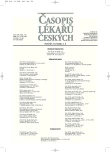Formation of the Urinary Stones in Alkaptonuria Patients
Authors:
J. Zadina 1; R. Průša 1; V. Goliáš 2; K. Štaifová 3
Authors‘ workplace:
Ústav klinické biochemie a patobiochemie 2. LF UK a FNM, Praha
1; Ústav geochemie, mineralogie a nerostných zdrojů, Přírodovědecká fakulta UK, Praha
2; Urologická ambulance, Praha
3
Published in:
Čas. Lék. čes. 2008; 147: 330-332
Category:
Case Report
Overview
Alkaptonuria is an autosomal recessive disease with late complications (arthritis and ochronosis). Excretion of alkapton (homogentisic acid) in the urine is due to congenital lack of the enzyme homogentisate 1,2-dioxygenase, which mediates the essential step in the catabolism of phenylalanine and tyrosine. Urine excretion of homogentisic acid is very high, urine turns dark if allowed to stand or is alkalinized (a result of formation of polymerization products of alkapton). The presence of alkapton in urine has high lithogenic effect. We report 71 years old man suffering from alkaptonuria with present severe late complications. In this man black coloured urinary calculus was extracted from the urethra. This calculus was formed of organic amorphous part and crystallized part analyzed by X-ray diffraction and infrared spectroscopy identifying weddelite and whitlockite (1:1), and trace amounts of carbonate apatite.
Key words:
urolithiasis, urinary calculi, alkaptonuria.
Sources
1. Menon, I. A., Persad, S. D., Haberman, H. F. et al.: Characterization of the pigment from homogentisic acid and urine and tissue from an alkaptonuria patient. Biochem. Cell Biol., 1991, 69, s. 269–273.
2. Sener, R. N.: Prostatic and renal stones and unilateral obstruction of the urinary tract caused by ochronosis. Amer. J. Radiol., 1992, 158, s. 214–215.
3. Phornphutkul, Ch., Introne, W. J., Perry, M. B. et al.: Natural history of alkaptonuria. N. Engl. J. Med., 2002, 347, s. 2111–2121.
4. Křížek, V.: Urolithiasis and prostatolithiasis in alcaptonuria with ochronosis. Int. Urol. Nephrol., 1971, 3, s. 245–250.
5. Křížek, V., Sadílek, L.: Urolitiáza. Etiopatogeneze, konzervativní terapie a prevence. Praha, Avicenum, 1990, 200 s.
6. Zibolen, M., Srsnova, K., Srsen, S.: Increased urolithiasis in patients with alkaptonuria in childhood. Clin. Genet., 2000, 58, s. 79–80.
7. Bartoníčková, K.: Urolitiáza. In: Schűck, O. et al.: Klinická nefrologie, Praha, Medprint, 1995, s. 179–198.
Labels
Addictology Allergology and clinical immunology Angiology Audiology Clinical biochemistry Dermatology & STDs Paediatric gastroenterology Paediatric surgery Paediatric cardiology Paediatric neurology Paediatric ENT Paediatric psychiatry Paediatric rheumatology Diabetology Pharmacy Vascular surgery Pain management Dental HygienistArticle was published in
Journal of Czech Physicians

Most read in this issue
- Formation of the Urinary Stones in Alkaptonuria Patients
- Changes in the Urinary Bladder Caused by Short-term Permanent Catheter Insertion
- Metabolic Syndrome and Skin Diseases
- Hypokalaemia in a Suicide Attempt of an Adolescent Girl
